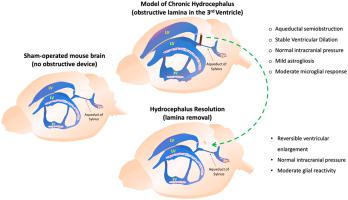Journal of Neuroscience Methods ( IF 2.7 ) Pub Date : 2021-07-20 , DOI: 10.1016/j.jneumeth.2021.109294 Tania Campos-Ordonez 1 , Oscar Gonzalez-Perez 2

|
Background
Hydrocephalus is a neurologic disturbance produced by the abnormal production, circulation, and absorption of cerebrospinal fluid (CSF). Late-onset idiopathic aqueductal stenosis induces normal pressure hydrocephalus (NPH) in adults. To date, no animal model replicating chronic NPH is available to study the pathophysiological changes observed in these subjects.
New Method
We performed and characterized a model that induces chronic hydrocephalus in the adult mouse brain by producing a pre-aqueductal semiobstruction using an acetate lamina inserted into the atrium of the aqueduct of Sylvius. After surgical procedure, we analyzed the hydrocephalus development on days 60 and 120 and sham-operated animals were used as controls. We included an additional group of hydrocephalus resolution in which we removed the obstruction and analyzed the morphological changes in the brain.
Results
The hydrocephalus was fully established on day 60 after the obstruction and remained stable for 120 days. In all animals, the intracranial pressure remained ~4.08 mmHg and we did not find statistically significant differences between the hydrocephalus groups and controls. We did not find motor impairments and anxiety-like behaviors among groups and the analysis of microglia and astrogliosis revealed mild glial reactivity.
Comparison with Existing Methods
This model generates a long-term ventricular enlargement with normal intracranial pressure and moderate glial reactivity. Importantly, this model allows the reversibility of ventricular enlargement after the removal of the obstructive film from the brain. Conclusions. This mouse model may be useful to study the long-term cerebral alterations that occur during NPH or after its surgical resolution.
中文翻译:

成人大脑中 Sylvius 导水管部分闭塞引起的慢性脑积水小鼠模型的表征
背景
脑积水是由脑脊液 (CSF) 的异常产生、循环和吸收引起的神经系统障碍。迟发性特发性导水管狭窄导致成人正常压力脑积水 (NPH)。迄今为止,还没有复制慢性 NPH 的动物模型可用于研究在这些受试者中观察到的病理生理变化。
新方法
我们执行并表征了一个模型,该模型通过使用插入 Sylvius 导水管心房的醋酸纤维层产生导水管前半阻塞来诱导成年小鼠大脑中的慢性脑积水。外科手术后,我们分析了第 60 天和第 120 天的脑积水发展,并使用假手术动物作为对照。我们包括了一组额外的脑积水解决方案,其中我们去除了阻塞并分析了大脑的形态学变化。
结果
脑积水在阻塞后第 60 天完全建立并保持稳定 120 天。在所有动物中,颅内压保持 ~4.08 mmHg,我们没有发现脑积水组和对照组之间存在统计学上的显着差异。我们没有发现各组之间的运动障碍和焦虑样行为,对小胶质细胞和星形胶质细胞增生的分析显示有轻度的神经胶质反应性。
与现有方法的比较
该模型产生具有正常颅内压和中等神经胶质反应性的长期心室扩大。重要的是,该模型允许从大脑中去除阻塞性薄膜后心室扩大的可逆性。结论。这种小鼠模型可能有助于研究 NPH 期间或手术解决后发生的长期大脑改变。











































 京公网安备 11010802027423号
京公网安备 11010802027423号